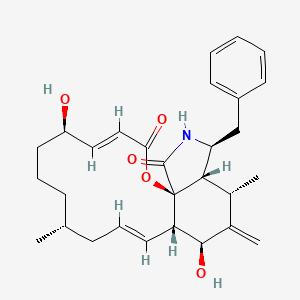| MeSH term | MeSH ID | Detail |
|---|---|---|
| Kidney Diseases | D007674 | 29 associated lipids |
| Leukemia | D007938 | 74 associated lipids |
| Leukemia, Experimental | D007942 | 42 associated lipids |
| Leukemia, Lymphoid | D007945 | 18 associated lipids |
| Leukemia, Myeloid | D007951 | 52 associated lipids |
| Lung Neoplasms | D008175 | 171 associated lipids |
| Lupus Erythematosus, Systemic | D008180 | 43 associated lipids |
| Lymphoma | D008223 | 18 associated lipids |
| Lymphoproliferative Disorders | D008232 | 7 associated lipids |
| Mammary Neoplasms, Experimental | D008325 | 67 associated lipids |
CYTOCHALASIN B
CYTOCHALASIN B is a lipid of Polyketides (PK) class. Cytochalasin b is associated with abnormalities such as Renal tubular disorder and Chagas Disease. The involved functions are known as Membrane Protein Traffic, inhibitors, Metabolic Inhibition, Biochemical Pathway and Increased Sensitivy. Cytochalasin b often locates in Cytoplasmic matrix, Plasma membrane, Microtubules, Extracellular and Protoplasm. The associated genes with CYTOCHALASIN B are SLC2A2 gene, PFDN5 gene, SLC2A1 gene, OMG gene and SPEN gene. The related lipids are Steroids, Lipopolysaccharides and Liposomes. The related experimental models are Xenograft Model.
Cross Reference
Introduction
To understand associated biological information of CYTOCHALASIN B, we collected biological information of abnormalities, associated pathways, cellular/molecular locations, biological functions, related genes/proteins, lipids and common seen animal/experimental models with organized paragraphs from literatures.
What diseases are associated with CYTOCHALASIN B?
CYTOCHALASIN B is suspected in Renal tubular disorder, Chagas Disease and other diseases in descending order of the highest number of associated sentences.
Related references are mostly published in these journals:
| Disease | Cross reference | Weighted score | Related literature |
|---|
Possible diseases from mapped MeSH terms on references
We collected disease MeSH terms mapped to the references associated with CYTOCHALASIN B
PubChem Associated disorders and diseases
What pathways are associated with CYTOCHALASIN B
There are no associated biomedical information in the current reference collection.
PubChem Biomolecular Interactions and Pathways
Link to PubChem Biomolecular Interactions and PathwaysWhat cellular locations are associated with CYTOCHALASIN B?
Visualization in cellular structure
Associated locations are in red color. Not associated locations are in black.
Related references are published most in these journals:
| Location | Cross reference | Weighted score | Related literatures |
|---|
What functions are associated with CYTOCHALASIN B?
Related references are published most in these journals:
| Function | Cross reference | Weighted score | Related literatures |
|---|
What lipids are associated with CYTOCHALASIN B?
Related references are published most in these journals:
| Lipid concept | Cross reference | Weighted score | Related literatures |
|---|
What genes are associated with CYTOCHALASIN B?
Related references are published most in these journals:
| Gene | Cross reference | Weighted score | Related literatures |
|---|
What common seen animal models are associated with CYTOCHALASIN B?
Xenograft Model
Xenograft Model are used in the study 'Endofacial competitive inhibition of the glucose transporter 1 activity by gossypol.' (Pérez A et al., 2009).
Related references are published most in these journals:
| Model | Cross reference | Weighted score | Related literatures |
|---|
NCBI Entrez Crosslinks
All references with CYTOCHALASIN B
Download all related citations| Authors | Title | Published | Journal | PubMed Link |
|---|---|---|---|---|
| Lin MC et al. | Eunicellin-based diterpenoids from the Formosan soft coral Klyxum molle with inhibitory activity on superoxide generation and elastase release by neutrophils. | 2013 | J. Nat. Prod. | pmid:24020806 |
| Wang L et al. | [Preparation of cytoplasts from HL-60 cells]. | 2013 | Sheng Wu Yi Xue Gong Cheng Xue Za Zhi | pmid:23865322 |
| Panteris E et al. | Differential responsiveness of cortical microtubule orientation to suppression of cell expansion among the developmental zones of Arabidopsis thaliana root apex. | 2013 | PLoS ONE | pmid:24324790 |
| Corpe CP et al. | Intestinal dehydroascorbic acid (DHA) transport mediated by the facilitative sugar transporters, GLUT2 and GLUT8. | 2013 | J. Biol. Chem. | pmid:23396969 |
| Lin T et al. | Chromosomes in the porcine first polar body possess competence of second meiotic division within enucleated MII stage oocytes. | 2013 | PLoS ONE | pmid:24312673 |
| Jiménez-Trigos E et al. | Post-warming competence of in vivo matured rabbit oocytes treated with cytoskeletal stabilization (Taxol) and cytoskeletal relaxant (Cytochalasin B) before vitrification. | 2013 | Reprod. Domest. Anim. | pmid:22448807 |
| Konya V et al. | Endothelial E-type prostanoid 4 receptors promote barrier function and inhibit neutrophil trafficking. | 2013 | J. Allergy Clin. Immunol. | pmid:22704539 |
| Bulychev AA et al. | Propagation of photoinduced signals with the cytoplasmic flow along Characean internodes: evidence from changes in chloroplast fluorescence and surface pH. | 2013 | Eur. Biophys. J. | pmid:23467782 |
| Nefic H and Handzic I | The effect of age, sex, and lifestyle factors on micronucleus frequency in peripheral blood lymphocytes of the Bosnian population. | 2013 | Mutat. Res. | pmid:23499242 |
| Maaty WS et al. | Identification of C-terminal phosphorylation sites of N-formyl peptide receptor-1 (FPR1) in human blood neutrophils. | 2013 | J. Biol. Chem. | pmid:23873933 |
